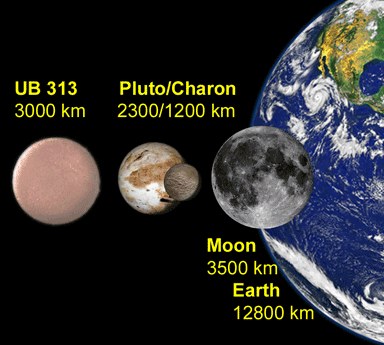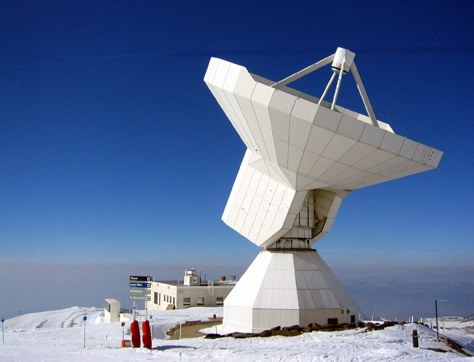New measurements published in the February 2 issue of Nature support claims last year that the planetary membership of our Solar System should be extended to include a tenth that is bigger than Pluto. 2003 UB313 was first spotted in January 2005 by Mike Brown’s team at Caltech, but recent thermal emission measurements have recently allowed German scientists to estimate its diameter at approximately 3100 km, some 700 km larger than Pluto. This makes it the biggest object to be discovered in the Solar System since the discovery of Neptune in 1846. For comparison, Earth’s Moon has a diameter of about 3500 km.
Like Pluto, UB313 is an icy body circling the Sun in the vast expanse beyond the orbit of Neptune known as the Kuiper belt. UB’s orbit takes it almost 100 times farther away from the Sun as the Earth and about twice as far as the most distant point of Pluto’s orbit. When astronomers first sighted it, there were hints that it was at least as big as Pluto, but a more accurate estimate would only be possible once astronomers had determined its albedo, or surface reflectance.

Planets
Now, Frank Bertoldi of the University of Bonn and the Max Planck Institute for Radio Astronomy (MPIfR) and MPIfR’s Wilhelm Altenhoff have resolved this albedo problem using measurements of the heat radiated by UB313 and comparing this with optical observations. The researchers detected the very faint millimetre wavelength emissions from UB313 using the IRAM 30-m telescope on Pico Veleta in southern Spain, and the very sensitive heat sensor MAMBO-2, which was developed and built at the MPIfR in Bonn by Ernst Kreysa’s group.
Astronomers have discovered numerous small planetary objects beyond the orbits of Neptune and Pluto since the early 1990s and so confirmed the prediction of Kenneth Edgeworth (1880-1972) and Gerard Kuiper (1905-1973) of a belt of such objects. These objects are thought to be the leftovers from the formation of the Solar System some 4.5 billion years ago. They evaded the gravitational clean-up that took place closer to the Sun but occasionally venture into this region as short-period comets.

Planetary detector
As evidence of small planetary objects accrues, the notion of what it takes to be a planet has changed. Since UB313 is decidedly larger than Pluto, Bertoldi explain, it is now increasingly hard to justify calling Pluto a planet if UB313 is not also given this status. One cynical journalist has already dubbed Pluto’s big brother Ooby, while others have mistakenly given it the name Xena. Astronomers are more likely to take a name from Roman mythology but the International Astronomical Union will have the final say.

Planetary telescope

Frank Bertoldi
Further reading
Nature 2006, 439, 563-564
http://dx.doi.org/10.1038/nature04494
Prof Dr Frank Bertoldi
http://www.astro.uni-bonn.de/~bertoldi/
New planet press release
http://www.astro.uni-bonn.de/~bertoldi/ub313/
Kuiper Belt
http://www.ifa.hawaii.edu/faculty/jewitt/kb.html
MAMBO
http://www.astro.uni-bonn.de/~bertoldi/projects/mambo/
IRAM
http://www.iram.fr/
Suggested searches
Kuiper Belt
Solar System
planets
thermal emission spectroscopy